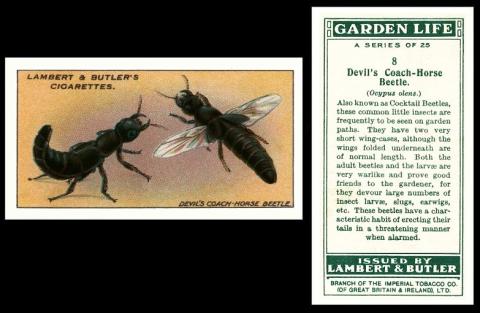
You may think this a curious creature, but it is quite usual to find them in hedgerows, scuttling along. and also in gardens, if you hunt under stones, though they also like the warmth of the compost heap. They are often mistaken for a scorpion, from the colour and from the curling action of their "tail" but this is just an elongated stomach and it does not sting, it only squirts a kind of smelly soup, which lingers despite washing.
However do let the "Devil" part of their name be a warning, for once roused they are mighty fighters, with strong pincer like jaws, capable of crushing other insects and giving a nasty nip to any intruding human fingers. And some people, especially children, are badly affected by them though, and suffer large blisters if they attempt to pick up the insect. It is thought that this is because many children start to crush it and then the beetle responds in the only way it can.
Now some places call this creature the cocktail beetle, but I have not discovered why, yet.
Our original Lambert & Butler Reference Book (RB.9 - published in 1948) described this set as :
49. 25. GARDEN LIFE. Fronts lithographed in colour without photo basis. Backs in dark green, with descriptions. 1930.
In our World Tobacco Issues Indexes, the description was reduced to : "Sm. Nd. (25)"
However there is another code above, the H code for the handbook, and this tells us that this set was not a one off, instead being issued by W.D. & H.O. Wills in October 1914, some sixteen years before our version, and also by Edwards, Ringer and Bigg in 1934, four years after ours, and twenty years after the original Wills printing.
Sadly there is no Edwards Ringer and Bigg Reference Book, but I do have a contemporary new issues report from The London Cigarette Card Company`s "Cigarette Card News" Vol.2, No.13, October 1934, under "Notes on Current Series - by C. L. Porter" which reads :
Edwards, Ringer & Bigg. This branch of the Imperial Tobacco Company are now packing in their "Klondyke" Cigarettes "Garden Life", a series of 25 small cards, similar to the Lambert & Butler set of the same name."
Now this does not mention the Wills original set, but the reason could be something which is revealed in our Wills Reference Book, where it tells us their original set was a series of fifty cards, double the size of the other two. So how, I wonder, were the cards selected? And did both those sets use the same cards and numbering system?
